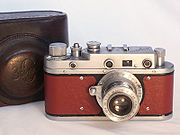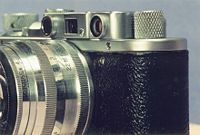
Zorki
Encyclopedia

Rangefinder
A rangefinder is a device that measures distance from the observer to a target, for the purposes of surveying, determining focus in photography, or accurately aiming a weapon. Some devices use active methods to measure ; others measure distance using trigonometry...
camera
Camera
A camera is a device that records and stores images. These images may be still photographs or moving images such as videos or movies. The term camera comes from the camera obscura , an early mechanism for projecting images...
s manufactured in the Soviet Union
Soviet Union
The Soviet Union , officially the Union of Soviet Socialist Republics , was a constitutionally socialist state that existed in Eurasia between 1922 and 1991....
between 1948 and 1978.
The Zorki was a product of the Krasnogorsk Mechanical Factory (KMZ)
Krasnogorskiy Zavod
Krasnogorskiy zavod im. S. A. Zvereva is a Russian factory in Krasnogorsk near Moscow which specializes in optical technology.During the Soviet period it was called Krasnogorsk Mechanical Works...
, which also produced the Zenit
Zenit (camera)
Zenit is a Russian camera brand manufactured by KMZ in the town of Krasnogorsk near Moscow since 1952 and by BelOMO in Belarus since the 1970s. The Zenit trademark is associated with 35mm SLR cameras...
single lens reflex camera (SLR). The first Zorki cameras were inexpensive Leica II copies just like the FED
FED (camera)
The FED is a Soviet rangefinder camera, mass produced from 1934 until around 1990, and also the name of the factory that made it.FED is indirectly named after Felix Edmundovich Dzerzhinsky, founder of the Cheka...
, but later models were considerably different from the Leica.
When using most Zorki cameras, the shutter speed should only be set after the shutter has been cocked. Setting the shutter speed before the shutter is cocked can permanently damage the camera. This especially affects all Zorki cameras with slow shutter speeds under 1/30 of a second, in particular the Zorki-3 and Zorki-4.
Zorki 1/2

Photographic lens
A camera lens is an optical lens or assembly of lenses used in conjunction with a camera body and mechanism to make images of objects either on photographic film or on other media capable of storing an image chemically or electronically.While in principle a simple convex lens will suffice, in...
, a collapsable lens which looked like the Leitz Elmar but was actually a copy of the Zeiss Tessar. Introduced in 1948, the Zorki 1 was the first 35mm camera made by KMZ. The Zorki S of 1955 added flash synchronisation.
The Zorki 2 (1954) was similar to the Zorki 1 but featured an updated rewind mechanism and a self timer
Self timer
A self timer is a device on a camera that gives a delay between pressing the shutter release and the shutter's firing. It is most commonly used to let photographers to take a photo of themselves , hence the name....
. There was a later flash version called the Zorki 2S.
Zorki 3
Introduced in 1951, the Zorki 3 was somewhat similar to the Leica III. It offered a number of improvements over the original Zorki, including a large combined viewfinder with the rangefinder builtin, a removable back, and a larger and faster Jupiter-8 (lens)Jupiter-8 (lens)
The Jupiter-8 is 50mm / f:2 Russian camera lens made by KMZ during the Soviet era. It was made to fit a number of different camera makes. It was available in the M39 lens mount, or "Leica thread mount", a bayonet mount to fit early Zeiss Contax cameras...
(Zeiss Sonnar
Zeiss Sonnar
The Sonnar is a photographic lens originally designed by Dr. Ludwig Bertele in 1924 and patented by Zeiss Ikon. It was notable for its relatively light weight, simple design and fast aperture. The name "Sonnar" is derived from the German word "Sonne", meaning sun...
copy) lens. It also added a new mechanism for slow shutter speed
Shutter speed
In photography, shutter speed is a common term used to discuss exposure time, the effective length of time a camera's shutter is open....
s with a separate selector dial on the front of the camera. This mechanism was unreliable, so the improved Zorki 3M of 1954 combined all of the shutter speeds on a single dial. The Zorki 3S, introduced in 1955, was a Zorki 3 with flash sync.
Zorki 4
The Zorki 4, 1956, was a Zorki 3S with self timer added. The Zorki 4K was identical but used a lever advance instead of the old-style wind knob. With over 2 million units produced, the Zorki 4 was the most successful Zorki and has a reputation as one of the best Russian cameras, although the self-timer and slow shutter speeds were unreliable. The Zorki Mir of 1959 was a lower-cost Zorki 4 with fewer shutter speeds.Zorki 35M
The Zorki-35M full-frame 35mm coupled-rangefinder camera was a project undertaken by KMZ designer N. Marienkov during the late 1960s (the "M" is his "signature" camera; he also designed the Zorki 3M and the Zenit 3M). It was based on the body of the Zenit E and some of the advanced design features of the Zenit D, but as a rangefinder rather than SLR camera. It was to feature bright-line frames in the viewfinder for 50mm and 85mm lenses, with the entire field of the viewfinder corresponding to that of a 35mm lens. Other advances included automatic parallax compensation, speeds from 1 to 1/1000 sec. and a modern body design. It was probably an attempt to make an updated alternative for the then aging Zorki 4. At least two hand-built prototypes of this camera are known to exist, and the KMZ archives list it as a "project", but it never went into production.Zorki 5/6
The Zorki 5 was an updated model similar to the FED 2FED (camera)
The FED is a Soviet rangefinder camera, mass produced from 1934 until around 1990, and also the name of the factory that made it.FED is indirectly named after Felix Edmundovich Dzerzhinsky, founder of the Cheka...
. There were two different versions, the first (1958) having an Industar-22 lens and the second (1959) having an Industar-50. Like early Leicas, the Zorki 5 was loaded with film by removing the bottom plate. The Zorki 6 was identical to the later version Zorki 5 but with a removable back for easier loading.
Zorki 10/11/12
The Zorki 10 was a modern-style 35mm rangefinder camera with a selenium light meterLight meter
A light meter is a device used to measure the amount of light. In photography, a light meter is often used to determine the proper exposure for a photograph...
and shutter priority
Shutter priority
Shutter priority refers to a setting on some cameras that allows the user to choose a specific shutter speed while the camera adjusts the aperture to ensure correct exposure...
automatic exposure introduced in 1964. The Zorki 11 was a cheaper model without the rangefinder, and the Zorki 12 was a variant using Agfa's Rapid film cartridges. All three variants had fixed (non-interchangeable) lenses.
The Zorki 10 is a fixed-lens Zorki coupled rangefinder camera with an integrated light meter. Selenium meter cells surround the lens. This was the first fully automatic camera produced in the former Soviet Union, as well as the first to use ASA/DIN markings rather than the Soviet GOST numbers, however these ASA numbers were still mostly useless as they didn't match any known film speeds (some Zorki 10 cameras apparently had GOST numbers instead of ASA though, as it's shown in a Polish camera manual).
The shutter release is a small lever protruding from the right-hand side of the lens. Shutter speeds from 1/30s to 1/500s were available in automatic mode. It also provided a B (bulb) setting, though there is no way to attach a cable release. Apertures from 2.8 to 22 with constant shutter speed of 1/30 s could be set in manual mode, intended for use with an electronic flash. Flash sync is possible at all shutter speeds through the PC terminal. There is an accessory shoe provided, but it does not sync with flash.
The Zorki 11 is a Zorki 10 without the coupled rangefinder mechanism, but with distance symbols visible in the viewfinder.
Technical specifications:
Film type: 135
Frame size: 24x36 mm
Viewfinder magnification: 0.65x
Rangefinder base: 38 mm
Lens: Industar 63, 45 mm f/2.8 (four element Tessar type)
Angle of view: 51.3 degree
Min. focusing distance: 1.5 m
Shutter: leaf; electronically controlled in auto mode, 1/30 s or B in manual mode.
Exposure metering: external with selenium meter
Shutter speed range: 1/30 s – 1/500 s, B
Aperture range: 2.8 – 22
Automatic exposure range: 8 – 18 EV
Manual exposure range: 8 – 14 EV
Film speed range: 20 – 320 ASA (14 – 26 DIN, 16 – 250 GOST)
Flash sync: 1/30 s
Film advance: manual
Selftimer: mechanical, 8-15 s delay
Filter thread: M52.5 x 0.75
Tripod thread: 1/4" or 3/8” (depending of manufacture period)
Dimensions: 129 x 77 x 76 mm
Weight: 750 g
List of Zorki cameras
- Zorki 1 (1948–1956)
- Zorki 3 (1951–1954)
- Zorki 2 (1954–1956)
- Zorki 3M (1954))
- Zorki S (1955–1958)
- Zorki 2S (1955–1960)
- Zorki 3S (1955–1956)
- Zorki 4 (1956–1973)
- Zorki 35M (Prototype only, c.1969)
- Zorki 5 (1958–1959)
- Zorki Mir (1959–1961)
- Zorki 6 (1959–1966)
- Zorki 10 (1964)
- Zorki 11 (1964)
- Zorki 12 (1967)
- Zorki 4K (1972–1978)

